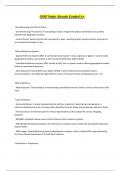GISP Study Already Graded A+
Georeferencing and Control Points
- Georeferencing: The process of associating a map or image with spatial coordinates to accurately
represent its geographic location.
- Control Points: Specific points that correspond in pairs, matching known spatial locations to points on
an unreferenced image or map.
Spatial Reference Systems
- Spatial Reference System (SRS): A coordinate-based system—local, regional, or global—used to locate
geographical entities, also known as the Coordinate Reference System (CRS).
- Coordinate Reference System (CRS): Similar to SRS, this is a system used to define geographical entities
within a coordinate framework.
- International Terrestrial Reference System (ITRS): A three-dimensional coordinate system
characterized by a well-defined origin (Earth's center of mass) and three orthogonal axes (X, Y, Z).
Map Projections
- Map Projection: The technique of transforming coordinates from the Earth's curved surface onto a flat
map.
Types of Datums
- Horizontal Datum: A model representing the Earth as a spheroid, featuring two components: a
reference ellipsoid and a set of survey points that determine its shape and positioning relative to Earth.
- Vertical Datum: A reference point for measuring elevations, often utilized for various mapping
purposes.
- NAVD88: A geodetic datum used in North America that is based on gravity.
- WGS 84 (World Geodetic System): The reference coordinate system utilized by the Global Positioning
System (GPS).
- SRID Integer: Spatial Reference System Identification numbers, which include EPSG codes defined by
the International Association of Oil and Gas Producers.
Distortions in Projections
,- Types of Distortion: Common forms include distance, direction, shape, and area, with occasional
impacts on bearing and scale.
Specific Map Projections and Their Distortions
- Mercator Projection:
- Preserves shape and direction but distorts area.
- Projects the Earth onto a cylinder tangent to a meridian.
- Azimuthal Projection:
- Maintains true distances from the center, while other properties distort with increasing distance.
- Utilizes a planar approach where a flat surface is placed on a globe, often centered on either the
North or South Pole for a distinct perspective.
- Cylindrical Projection:
- Preserves area and shape but distorts distance, particularly at the upper and lower regions.
- Two types: Tangent (one intersection) and Secant (two intersections), where meridians are straight
and equally spaced while parallels vary in spacing.
- Conical Projection:
- Preserves direction and area in limited regions but distorts distance and scale away from the standard
parallels.
- Achieved by mapping the surface of a sphere onto a cone.
Choosing the Appropriate Projection
- For Low Latitude (near the Equator): Prefer conical projections.
- For High Latitude (polar regions): Employ azimuthal planar projections.
- For a broad East-West extent (e.g., USA): Utilize conical projections.
- For a broad North-South extent (e.g., Africa): Opt for transverse cylindrical projections.
- For Thematic mapping comparing values across locations: Use equal-area projections.
,Geometric Concepts
- Discrete Features: Characteristics with definable boundaries, typically represented by vectors.
- Continuous Phenomena: Measurements associated with each location, often related to temperature or
elevation, typically represented by rasters though not exclusively.
- Geoid: The shape that the ocean's surface would take under the influence of Earth's gravity and
rotation, disregarding wind or tidal effects.
- Mean Sea Level (MSL): Determined by referencing the geoid model, which marks sea level at coastal
locations using tide gauges.
- Reference Ellipsoid: A mathematically defined surface that approximates the geoid, providing a truer
model of its shape.
oblate ellipsoid ✅103- fits the geiod model to a first order approximation
formed when an ellipse is rotated about its minor axis (The shape of the Earth, slightly bulging at the
Equator.)
sphere ✅103- can be seen from dimensions of the Earth ellipsoid
the semi-major axis (a) and semi-minor axis (b) differ by little more than 21 kilometers
first (direct) geodetic problem ✅103- Given a point (coordinates) and direction (azimuth) and distance
from that point to a second point, determine the coordinates of a second point
Be prepared for Word Problems like this one
Second (inverse) geodetic problem ✅103- given two points, determine the azimuth and length of the
line that connects them (line may be straight, arc, or geodesic)
Be prepared for Word Problems like this one
Geomatics ✅104- branch of science (and technology) of collection, analysis, interpretation of
geographic information
(includes surveying, mapping, remote sensing, GIS, GPS)
GPS (global positioning system) ✅104- A system that determines the precise position of something on
Earth through a series of satellites, tracking stations, and receivers.
, Spatial Modeling ✅201- A methodology or set of analytical procedures used to derive information
about spatial relationships between geographic phenomena.
Types of spatial models ✅201-
Vector
Raster
Pixel
Geodatabase
Grid
TIN
Topological
Hierarchical
Network
Object Oriented
Vector Spatial Modeling ✅201- coordinated based data model (points, lines, and polygons)
Vector Spatial Modeling- Points ✅201- Discrete locations represented by a coordinate pair, attributes
can be associated
(e.g. Sign, city centers, geocoding addresses)
Vector Spatial Modeling- Lines ✅201- Linear features composed of an ordered list of vertices, attributes
can be associated
(e.g. rivers, roads, utility lines)
Vector Spatial Modeling- Polygons ✅201- composed of nodes and vertices forming bounded areas; start
and end node are the same, attributes can be associated
(e.g. water bodies, parcels, land masses)




